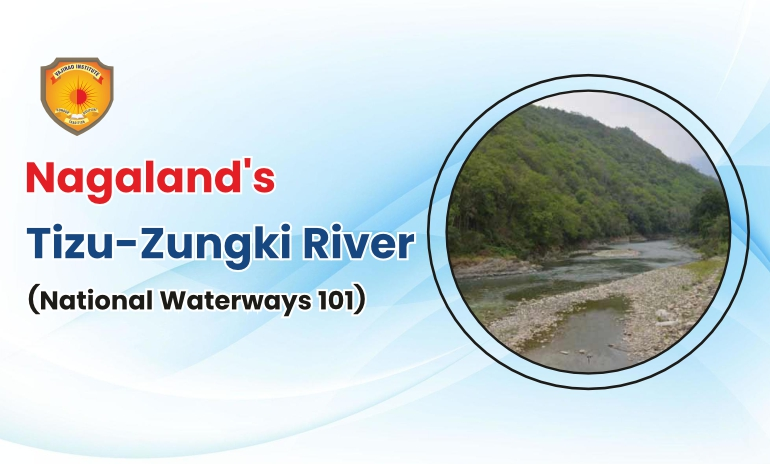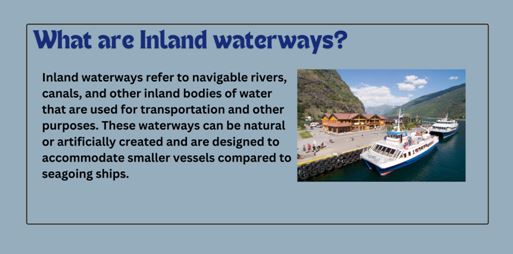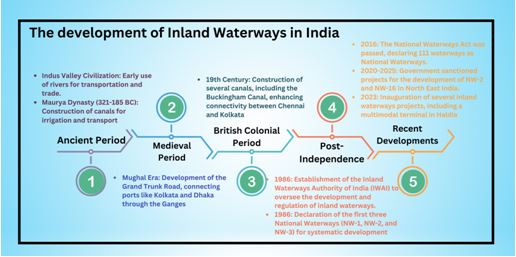
Context:The Union Minister of Ports, Shipping and Waterways recently announced that the ministry has decided to carry out feasibility studies to use the National Waterways-101 on the Tizu Zunki River for the transportation of cargo and passengers.
Key Facts about Tizu River
- Dhiku, Dhansiri, Doyang and Tizu are major rivers of the state of Nagaland.
- The major feeders to the River Tizu include Zungki, Lanye, and Likimro rivers.
- While, the Tizu River System flows mainly east and southeast and drains itself into Irrawaddy in Myanmar, the DhikuRiver, Dhansiri River, DoyangRiver all flow westward in the plains of Assam and join the river Brahmaputra.
- The main drainage system in the eastern region of Nagaland is Tizu River. Originating in the central part of the state of Nagaland, and it goes through the districts of Phek and Kiphire and in confluence with the Myanmar’s Chindwin River.
- The Chindwin River mergesinto Myanmar’s river Irrawaddy.
- Mandalay is a major port situated in its bank.
- Irrawaddy ultimately flows into the Andaman Sea through the Irrawaddy Delta.
- Flora and Fauna: it includes the Great nawab Butterflies, bamboo, lichens and cane species. It is surrounded by dense forest and Blue Mountains.
Nagaland's Tizu-Zungki (NW 101)
- Chindwin has a noteworthy water stream called Tizu-Zungki that is found in Kiphire, Nagaland state.
- The NW 101 passes through Nagaland starting from Longmatra (Nagaland) and passes up to Avangkhu.
- This project lengths 41 kilometres.
National Waterways
- These are the inland waterways for the transportation purpose.
- India has above 12,000 km of waterways that are easily navigable.
- For the Inland waterways in Indiathe regulating body is Inland waterways authority of India.
- About more than 125 million metric tonnes of cargo is transported through these waterways.
Functions of IWA

What are Inland waterways?

Inland waterways can be categorized into three main types:
- Natural Rivers: These are the real, non-artificial rivers that can be sailed without much human interferences. In India they include the Ganga and the Brahmaputra rivers.
- Canalized Rivers: These are real river systems which have been altered through various techniques including, dredging of the existing water channels, construction of locks and protection walls among others. An example of this is the Yamuna River that has been canalized.
- Artificial Canals: These are artificial channels developed to join one water body to the other or to have a channel where there is no natural one. Example Buckingham Canal.
These have the major functions of transportation and irrigation, and also used for generating hydro power.
Development of Inland water ways in India

How are these water ways beneficial?
These Inland Waterways in India can a significance role in the key development and the transportation in the country. It can be seen by the followings points:
- Cost-Effective: Inland water transport is a cheaper option than both road and Rail transport despite taking longer time to transport goods. For instance, 10 HP can do 40000 kg on water while on road it can only do 1500 kg.
- Energy-Efficient: Inland water transport again uses less amount of fuel. On water one litre of fuel can perform 105 tonne/km whereas on the road 1 litre of fuel can perform 24tonne/km.
- Environmentally Friendly: This mode of transport causes little harm to the environment in terms of emission of green-house gases hence lowering the level of pollution.
- Reduced Congestion: The use of water transport can be said to have a positive impact on road and railway hence reducing on the many cases of accidents that normally occur and the traffic jams as well.
- Economic Growth: Transportation through inland waterways encourages industrial development, tourism, and trade since it cuts on cost of transport.
- Accessibility: They avail hard-to-reach areas, regions and rural areas, a small increasein connection can bring growth and development top their doorstep.
- Employment Opportunities: Hydraulic improvement entails the management and advance of inland waterways for transportation and other uses and this may generate employment opportunities across several industries such as; machine, food, raw material etc.
Key Challenges associated to it are:
Inland waterways in India face several challenges that hinder their full potential which includes the following:
- Seasonal Variations: Rivers gets destructive especially during monsoon season therefore making navigation of the water bodies during the mentioned seasons a nightmare.
- Siltation and Erosion: There has been problem of siltation which affects the depth and also the width of waterways through bank erosion.
- Infrastructure Gaps: There is poor provision of hard infrastructural-developmental facilities like terminal, jetties, and storage facilities along the waterways.
- Technical Issues: Poor vertical and horizontal management on bridges and other structures hinder passage of the vessels.
- Regulatory Challenges: There is poor co-ordination between different state governments and other regulatory bodies which results to organizational complexities.
- Financial Constraints: Inadequate financial resources available for carrying out construction and for sustaining the inland waterways.
- Environmental Concerns: Concerning the environmental issue, traveling through areas of ecological importance may act as a threat to the environment
How to improve Inland waterways ?
Improving infrastructure for inland waterways in India involves several strategic steps:
- Dredging and Maintenance: it is considered important to dredge rivers frequently to ensure they have the right depth so that vessels can have an easy time passing through them. It also prevents the accumulation of silt to hinder free passage of vessels.
- Modern Terminals and Jetties: Efficiency can be benefited with modern terminals and jetties accompanied by facilities for loading, unloading, and storage.
- River Information Systems (RIS): The use of modern and sophisticated systems in River Information Systems such as GPS and digital aids to navigation enhances safety and especially for night navigation.
- Intermodal Connectivity: Optimizing the inter-connectedness of waterways, rail and road can significantly cuts on transportation expenses of products.
- Public-Private Partnerships (PPP): In one hand PPP models help can bring in investment and expertise needed for development of infrastructure on the other hand it promotes private sectors participation.
- Policy and Regulatory Support: Integration of policies and regulations affecting the ease of movement of goods and elimination of bureaucracies affecting the same.
- Environmental Sustainability: Making sure that infrastructural development is eco-friendly with special regards to the water systems.
- Skill Development: The provision of training facilities for producing human resource for managing and maintaining inland waterway system.
- International Collaboration: Engaging Bangladesh, Nepal and Bhutan the neighbouring countries in order to improve trade and connectivity among the countries.
Inland waterways in India offer cost-effective, energy-efficient, and environmentally friendly transportation. Key waterways like the Ganga and Brahmaputra are crucial for trade and connectivity. It has a vast future improvement scope including regular dredging, modern terminals, advanced navigation systems, and better intermodal connectivity. Public-private partnerships and streamlined regulations will further enhance infrastructure, making inland waterways a vital component of India’s transportation network and can make India’s position Strong in the Field of Inland waterway Transportation.